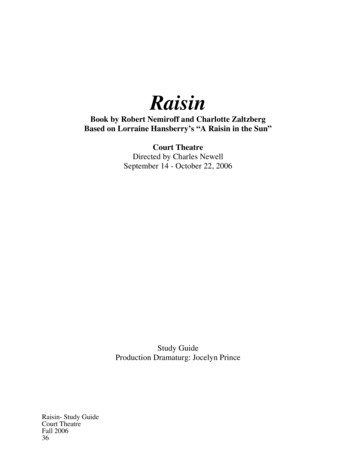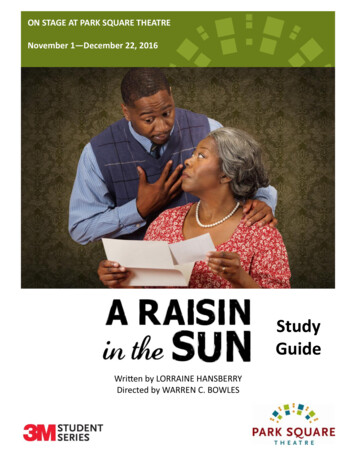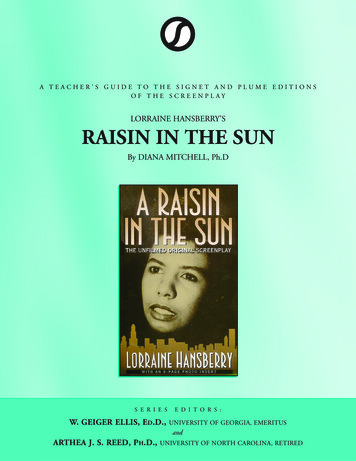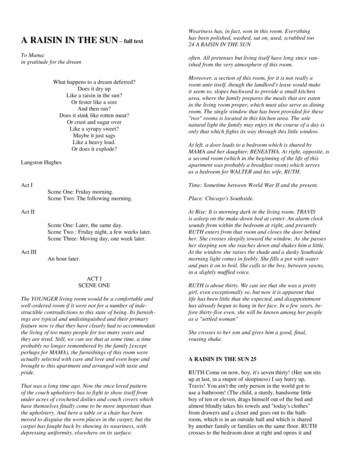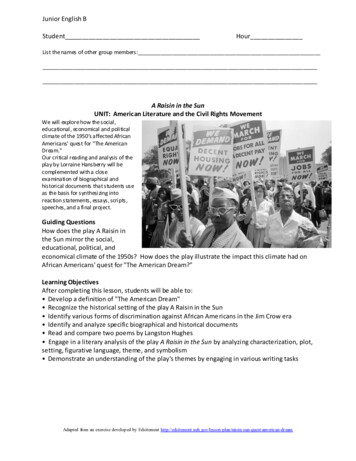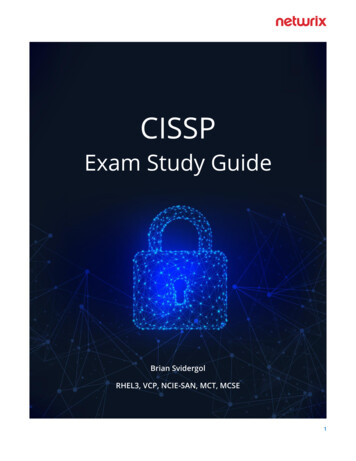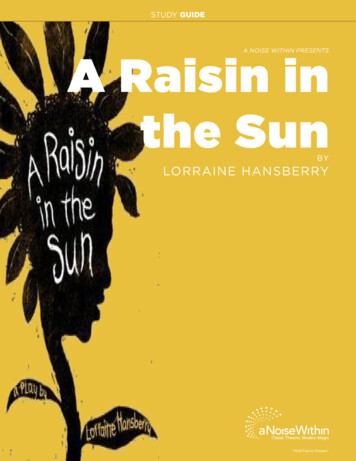
Transcription
STUDY GUIDEA NOISE WITHIN PRESENTSA Raisin inthe SunBYLORRAINE HANSBERRY“Hold Fast to Dreams”
STUDY GUIDES FROM A NOISE WITHINA rich resource for teachers of English,reading arts, and drama education.Dear Reader,We’re delighted you’re interested in our study guides,designed to provide a full range of information on ourplays to teachers of all grade levels.A Noise Within’s study guides include: eneral information about the playG(characters, synopsis, timeline, and more) Playwright biography and literary analysis Historical content of the play Scholarly articles Production information(costumes, lights, direction, etc.) Suggested classroom activities Related resources (videos, books, etc.) Discussion themes ackground on verse and proseB(for Shakespeare’s plays)Our study guides allow you to review and shareinformation with students to enhance both lesson plansand pupils’ theatrical experience and appreciation. Theyare designed to let you extrapolate articles and otherinformation that best align with your own curricula andpedagogic goals.More information? It would be our pleasure. We’re hereto make your students’ learning experience as rewardingand memorable as it can be!All the best,Alicia GreenDIRECTOR OF EDUCATIONPictured: Donnla Hughes, Romeo and Juliet, 2016. PHOTO BY CRAIG SCHWARTZ.
TABLE OF CONTENTSCharacters. . . . . . . . . . . . . . . . . . . . . . . . . . . . . . . . . . . . . . . . . . . 4Synopsis . . . . . . . . . . . . . . . . . . . . . . . . . . . . . . . . . . . . . . . . . . . . 5Playwright Biography: Lorraine Hansberry . . . . . . . . . . . . . . . . . 6Lorraine Hansberry Timeline . . . . . . . . . . . . . . . . . . . . . . . . . . . . 7Lorrain Hansberry: A Trailblazer. . . . . . . . . . . . . . . . . . . . . . . . . . 8Timelines:African American Theatre . . . . . . . . . . . . . . . . . . . . . . . . . . . 9Civil Rights Movement. . . . . . . . . . . . . . . . . . . . . . . . . . . . . 10Lorraine Hansberry: Civil Rights Activist. . . . . . . . . . . . . . . . . . 11Escalation of activism and militancy . . . . . . . . . . . . . . . . . . . . . 12Structural Racism Near and Far. . . . . . . . . . . . . . . . . . . . . . . . . 13The Great Migration . . . . . . . . . . . . . . . . . . . . . . . . . . . . . . . . . 15The Black Belt. . . . . . . . . . . . . . . . . . . . . . . . . . . . . . . . . . . . . . . 16The Persistence of Structural Racism:Income Gaps in Chicago . . . . . . . . . . . . . . . . . . . . . . . . . . . 17Income Gaps in Los Angeles. . . . . . . . . . . . . . . . . . . . . . . . 18Segregation in Chicago and Los Angeles. . . . . . . . . . . . . . 19Langston Hughes: “Harlem—Dream Deferred” . . . . . . . . . . . . 20Themes . . . . . . . . . . . . . . . . . . . . . . . . . . . . . . . . . . . . . . . . . . . . 21Q&A with Set Designer . . . . . . . . . . . . . . . . . . . . . . . . . . . . . . . 24Director’s Thoughts about A Raisin in the Sun . . . . . . . . . . . . . 25Actor Interview: A Raisin in the Sun. . . . . . . . . . . . . . . . . . . . . . 26Glossary and Colloquial Terms. . . . . . . . . . . . . . . . . . . . . . . . . . 28Essay Topics & Activities . . . . . . . . . . . . . . . . . . . . . . . . . . . . . . 29Resources and Suggestions for Further Reading . . . . . . . . . . . 31A NOISE WITHIN’S EDUCATION PROGRAMS MADE POSSIBLE IN PART BY:AMCAnn Peppers FoundationThe Jewish CommunityFoundationCapital Group CompaniesRalph M. Parsons FoundationThe Dick and Sally RobertsCoyote FoundationPasadenaCommunity FoundationThe Green FoundationDwight Stuart Youth FundEmployees CommunityFund of BoeingKenneth T. andEileen L. Norris FoundationMichael J. Connell FoundationRotary Club of PasadenaEdison InternationalSteinmetz FoundationWells FargoSpecial thanks to our 25th Anniversary Galadonors who kept the arts thriving this year bysupporting our Student Matinees (SMATs):SMAT PRODUCTIONSPONSOR ( 10,000 )Heather & Paul HaagaWilliam &Priscilla KennedyJames & Trevessa TerrileSMAT PERFORMANCESPONSOR ( 5,000 )Kathleen &James DrummyRebecca & Stuart BowneSharon & Rick EllingsenAlan M. &Sheila R. LamsonJohn K. &Barbara LawrenceRoger &Gloria V. MullendoreRichard & Sally RobertsEllen & Charlie SteinmetzLyn SpectorBill & Rebecca WoodsSCHOOL SPONSOR( 2,500 )Mr. & Ms.Roger EngemannBarbara HendersonMark & Louisa NelsonCLASS SPONSOR( 1,000 )William & Sasha AnawaltPeter & Molly BachmannBill & Claire BogaardDennis & Susan De PietroPat & Sandy GageCraig Gilmore &David CrockerArmando Gonzalez &Brenda BergShiela Grether-Marion &Mark MarionPat HoppeElyse KleinValerie & Bruce MerrittTerri MurrayCynthia J. Nunes &Barbara NyeDaniel RothmullerMargaret H. SedenquistWORKSHOP SPONSOR( 500 )Mads & Susan BjerreMartin & Nancy ChalifourAngela Conner &Kevin SpeaksJack & Becky DoodyThe Dutka FamilyDavid Dwiggins &Clare BarenPatrick GarciaKathleen GilmoreDiane Glatt & David HoltzRyan & Denise JayMolly JosephTheodore Krontiris &Sue ParillaKathy & John KurfessDeborah Smith &Carole LambertGloria & Tom LangJoe & Denise LumardaGene & Joanne MasudaEmily & Finnian MurrayBarbara &Anthony PhillipsVickie & Alex TaylorBetsy & Frank UlfBUS SPONSOR ( 350 )Bill & Susan BoydMeg Huntington Cajero &Paul CajeroMr. Laurence EggersKatherine James &Alan BlumenfeldJim KellyDavid & Bridget PrinceLouise Mayeri SpillmanRhonda StoneCraig & Carolyn WatsonADDITIONAL DONORSMarcelino MiyaresLinda DozierElsbeth CollinsBob NovellJanet SuzukiDavid BridenAngela HowellMayor Terry TornekBill UkropinaKate AustinGreg DerelianPatrick Ross
4 A NOISE WITHIN 2017/18 REPERTORY SEASON Spring 2018 Study GuideA Raisin in the SunCHARACTERSLena Younger“Mama” as she is referred to in theplay. She is the widowed matriarchof the Younger family. She is themother of Walter Lee and Beneatha.Beneatha YoungerWalter Lee’s youngersister. She is a collegestudent who dreamsof becoming a doctor.Walter Lee YoungerMama’s oldest child. He works asa chauffeur for a wealthy whitefamily, and dreams for a betterlife. He is married to Ruth Younger.Ruth YoungerThe peacemaker in the family.She is married to Walter Lee.She cares deeply about herhusband and family. Out ofeveryone in the family, she is themost excited about the prospectof moving to a new house.Travis YoungerRuth and Walter Lee’s son. Heis close with both of his parentsand loves his grandmother.Joseph AsagaiA student from Nigeria.He is in love withBeneatha.BoboWalter Lee’s business partner.Bobo and Walter Lee try toopen a liquor store together.Karl LindnerA representative of the Clybourne ParkImprovement Association who comesto make a deal with the Youngers.George MurchisonGeorge is Asagi’s competition for theaffections of the lovely Beneatha. He’s reallygood looking and his family has tons of money.Edited from: 10/PlayGuide RaisinintheSun.pdf
5 A NOISE WITHIN 2017/18 REPERTORY SEASON Spring 2018 Study GuideA Raisin in the SunSYNOPSISIn a crammed apartment on the south side of Chicago,the Younger family waits for a 10,000 life insurancecheck after the death of Mr. Younger. As they wait,differences arise as the members of the family try todecide how they should spend the money. Each adultfamily member has something for which they would liketo use the money, whether it is education, a businessinvestment, or a house to call their own. Dreams competeas each character pursues his or her vision of what lifecould be. What will happen when the possibilities of themoney cause rifts in relationships? How will the familyreact when given a chance to compromise their dignityfor their dreams? Where will they find their roots? InAmerica or in Africa? In their apartment or a new home?Alone or together?The “Hansberry House”Throughout the play, a number of important eventsoccur: First, Lena decides to use a large portion of themoney to buy a house in Clybourne Park, an all-whiteneighborhood in Chicago. Lena then gives the rest ofthe money from the insurance check to Walter Lee,and advises him to save a large portion of it to pay forBeneatha’s education. However, instead of saving themoney, Walter uses his share of the insurance check totry to open a liquor store with Bobo and Willy Harris.Only later does Walter Lee realize that he has beenscammed, and that he has lost all of the money from thecheck that he invested in the store.The family struggles to remain optimistic, especially whenKarl Lindner, a spokesperson from the Clybourne Parkcommunity, comes to make a deal with the Youngers. Inan attempt to keep the family from moving to ClybournePark, he offers to buy them out of their new house. Thisoffer sends each member of the family into a whirlpoolof mixed emotions and reactions. Walter Lee figuresthat giving in to “The Man” is the only way to get somemoney for his family. In the play’s climactic moment,Walter must choose between standing up for his family’srights and standing up for his ego and role as thebreadwinner. Ultimately, Walter Lee courageously standsup for civil rights and refuses Karl’s offer. The family willmove into their new home. Edited from: 10/PlayGuide RaisinintheSun.pdf
6 A NOISE WITHIN 2017/18 REPERTORY SEASON Spring 2018 Study GuideA Raisin in the SunABOUT THE PLAYWRIGHT LORRAINE HANSBERRYLorraine Hansberry is best know for her work, A Raisinin the Sun, a play about a struggling black family, whichopened on Broadway to great success. Hansberry wasthe first African American playwright and the youngestAmerican to win a New York Critics’ Circle award.Throughout her life, she was deeply involved in the CivilRights Movement. At the young age of 34, LorraineHansberry passed away from pancreatic cancer.EARLY LIFELorraine Vivian Hansberry was born on May 19, 1930, inChicago, Illinois. Hansberry’s father was a successful realestate broker, and her mother was a schoolteacher. Herparents contributed large sums of money to the NAACPand the Urban League—organizations dedicated toadvancing social, economic, and legal equity for AfricanAmericans. In 1938, Hansberry’s family moved to awhite neighborhood where they were violently attackedby their neighbors. They refused to move until a courtordered them to do so. However, their case made it tothe Supreme Court as Hansberry v. Lee, and the SupremeCourt’s decision in this case ruled restrictive covenantsillegal. Hansberry broke her family’s tradition of enrollingin Southern black colleges and instead attended theUniversity of Wisconsin in Madison. While at school, shechanged her major from painting to writing, and after twoyears, decided to drop out and move to New York City.COMMERCIAL SUCCESSIn New York, Hansberry attended the New Schoolfor Social Research and proceeded to work for PaulRobeson’s progressive black newspaper, Freedom, as awriter and associate editor from 1950 to 1953. She alsoworked part-time as a waitress and cashier, and wrotein her spare time. By 1956, Hansberry quit her jobs inorder to write full time. In 1957, she joined the Daughtersof Bilitis—one of the first organizations for lesbian civiland political rights in the US— and contributed lettersto their magazine, The Ladder, about feminism andhomophobia. Because of the nature of these letters, shewrote under her initials, L.H.N., for fear of discrimination.During this time, Hansberry wrote The Crystal Stair,a play about a struggling African American family inChicago, which was later renamed A Raisin in the Sun, atitle that comes from a line in a Langston Hughes poem.The play opened at the Ethel Barrymore Theatre in NewYork on March 11, 1959, and was a great success—itran for 530 performances. It was the first play producedon Broadway by an African American woman. The filmversion of A Raisin in the Sun starring Sidney Poitier wascompleted in 1961, and received an award at the CannesFilm Festival.Lorraine HansberryIn 1963, Hansberry became active in the Civil RightsMovement. Along with other influential people, includingHarry Belafonte, Lena Horne and James Baldwin,Hansberry met with then attorney general RobertKennedy to test his position on civil rights. In 1964, hersecond play, The Sign of Sidney Brustein’s Window,opened on Broadway to an unenthusiastic reception.PERSONAL LIFE AND LEGACYHansberry met Robert Nemiroff, a Jewish songwriter,on a picket line, and the two were married in 1953.Hansberry and Nemiroff divorced in 1962, though theycontinued to work together. In 1964, the same year TheSign in Sidney Brustein’s Window opened, Hansberry wasdiagnosed with pancreatic cancer. She died on January12, 1965. After her death, Nemiroff adapted a collectionof her writings and interviews in To Be Young, Gifted andBlack, which opened off-Broadway at the Cherry LaneTheatre and ran for eight months.A Raisin in the Sun is considered one of the hallmarksof the American stage and has continued to find newaudiences throughout the decades, including Emmynominated television productions from both 1989 and2008. The play has earned accolades from Broadway aswell, winning Tony Awards in 2004 and 2014, includingBest Revival of a Play. Edited from: www.biography.com/people/lorraine-hansberry
7 A NOISE WITHIN 2017/18 REPERTORY SEASON Spring 2018 Study GuideA Raisin in the SunLORRAINE HANSBERRY TIMELINEMay 19, 1930Lorraine Vivian Hansberry is born in Chicago, Illinois.She is the granddaughter of a freed slave, and theyoungest of four children.1938Hansberry’s family moves to a white neighborhoodand is violently attacked by neighbors. They refuseto move until a court orders them to do so. The casesurrounding the attacks makes it to the SupremeCourt as Hansberry v. Lee. Because of this case, theSupreme Court rules that restrictive covenants areillegal.1950 to 1953Hansberry attends the New School for SocialResearch in New York and then works for PaulRobeson’s progressive black newspaper, Freedom,as a writer and associate editor.1953Hansberry meets Robert Nemiroff, a Jewishsongwriter, on a picket line, and the two are married.1956Hansberry quits her jobs and commits her time towriting.1957Hansberry joins the Daughters of Bilitis organizationand contributes letters about feminism andhomophobia to their magazine, The Ladder.March 11, 1959Hansberry’s play The Crystal Stair (changed to ARaisin in the Sun) is about a struggling about astruggling African American family in Chicago, opensat the Ethel Barrymore Theatre in New York and runsfor 530 performances. It was the first play producedon Broadway by an African American woman, andHansberry was the first black playwright and theyoungest American to win a New York Critics’ Circleaward.1961The film versionof The CrystalStair is madeinto a film andrenamed ARaisin in theSun, starringSidney Poitier.The filmreceives anaward at theCannes FilmFestival.1962Hansberry and Nemiroffdivorce, however, they continue to work together.1963Hansberry becomes active in the Civil RightsMovement. Along with other influential people,including Harry Belafonte, Lena Horne, and JamesBaldwin, Hansberry meets with general RobertKennedy to test his position on civil rights. Thissame year, Hansberry’s second play, The Sign inSidney Brustein’s Window, opens on Broadway tounenthusiastic reception.1964Hansberry is diagnosed with pancreatic cancer.1965Hansberry dies on January 12.1969Nemiroff adapts a collection of Hansberry’s writingand interviews in To Be Young, Gifted and Black,which opens off-Broadway at the Cherry LaneTheatre and runs for eight months.Source Material: www.biography.com/people/lorrainehansberry-9327823
8 A NOISE WITHIN 2017/18 REPERTORY SEASON Spring 2018 Study GuideA Raisin in the SunLORRAINE HANSBERRY: A TRAILBLAZERLorraine Hansberry was the first African Americanwoman to write a play performed on Broadway.Hansberry’s family struggled against the injustices ofsegregation in their Supreme Court case, Hansberry v.Lee, which challenged the restrictions imposed on AfricanAmericans to only lease or purchase homes in certainneighborhoods. Hansberry v. Lee is now cited in lawclasses as an example of how civil cases can be tried asecond time as long as it is brought to the court by a newplaintiff who was not represented in the first civil action.Hansberry recalls her family’s case: “Twenty-fiveyears ago, [my father] spent a small personal fortune,his considerable talents, and many years of hislife fighting, in association with NAACP attorneys,Chicago’s ‘restrictive covenants’ in one of this nation’sugliest ghettos. That fight also required our familyto occupy disputed property in a hellishly hostile‘white neighborhood’ in which literally howling mobssurrounded our house. My memories of this ‘correct’way of fighting white supremacy in America include beingspat at, cursed and pummeled in the daily trek to andfrom school. And I also remember my desperate andcourageous mother, patrolling our household all nightwith a loaded German Luger [pistol], doggedly guardingher four children, while my father fought the respectablepart of the battle in the Washington court.”A Raisin in the Sun, which addresses issues surroundingrace and housing in Chicago, premiered on Broadwayin 1959. It became a film in 1961, and a musical in 1973.It was revived on Broadway in 2004 and again in 2014.New film versions also came out in 1989 and 2008. ARaisin in the Sun also inspired the play Clybourne Park byBruce Norris, which was awarded the 2011 Pulitzer Prizefor Drama, as well as Beneatha’s Place by Kwame KweiArmah.This play undeniably influenced the American theatreand its relationship to the Civil Rights Movement. Seethe timeline on the next page to compare importantmilestones in the Civil Rights Movement with thedevelopment of African American Theatre. Images and Material used with permission from Seattle RepertoryTheatre: k/RS Playguide.pdf
9 A NOISE WITHIN 2017/18 REPERTORY SEASON Spring 2018 Study GuideA Raisin in the SunAFRICAN AMERICAN THEATRE TIMELINE1816 William Henry Brown starts the African Companyin New York. This company attracts white patrons andserves as a training ground for some of the first AfricanAmerican Shakespearean actors.1955 Trouble in Mind is produced at the GreenwichMews and wins the Obie Award for best Off-Broadwayplay, making playwright Alice Childress the first AfricanAmerican woman to be awarded the honor.1823 William Henry Brown writes and produces KingShotaway, the first play publicly produced by an AfricanAmerican. The play is based on a slave rebellion on theisland St. Vincent which, at the time, was under Britishrule. The production starred James Hewlett and IraAldridge.1959 Lorraine Hansberry’s A Raisin in the Sun debuts onBroadway. Hansberry becomes the first African Americanwoman to have a play on Broadway. The play reveals thestruggles associated with black identity and the relatedroadblocks to achieving the American Dream.1848 Blackface minstrel shows become popular,translating formal art such as opera into more popularterms for a general audience. Minstrel shows portrayAfrican Americans as dim-witted, lazy, buffoonish,superstitious, happy-go-lucky, and musical.1916 Rachel, by Angelina Weld Grimke, is consideredthe first successful African American play for its protestof The Birth of a Nation—a film famous for its technicalachievement and infamous for its overtly racist message.1921 Shuffle Along is the first musical written, produced,and performed by African American theatre artists onBroadway.1935 Langston Hughes’ play, Mulatto, debuts onBroadway. It is the first African American musical onBroadway to be a commercial success.1940 American Negro Theatre (ANT) and NegroPlaywrights’ Company (NPC) are established as anoutgrowth of the Federal Theatre Project (FTP). NPCmembers include Richard Wright, Langston Hughes, andEdna Thomas.1944 The Library Theatre, located in Harlem producesAnna Lucasta by Philip Yordan with an all-AfricanAmerican cast on Broadway.1965 Amiri Baraka (originally LeRoi Jones) establishesthe Black Arts Repertory Theatre in Harlem. He inspiresartists like playwright Ed Bullins to create a strong “blackaesthetic” in American theatre.1969 The Langston Hughes Performing Arts Institute isfounded in Seattle, serving as both a neighborhood youthrecreation center and an artistic space for black poets,dancers, and actors to train and perform. Seattle’s firstblack theatre company Black Arts/West is founded.1983 August Wilson receives the Pulitzer Prize for hisplay Fences. This honor is awarded to him again in 1990for his play The Piano Lesson.1990 Suzan-Lori Parks wins her first Obie Award for herplay Imperceptible Mutabilities in the Third Kingdom. Hersubsequent awards include the 1996 Pulitzer for Venus,the 2002 Pulitzer for Topdog/Underdog, and the 2014Obie for Father Comes Home from the Wars Parts 1, 2,& 3.2006 The Hansberry Project is officially launched inSeattle as an African American theatre lab, led by AfricanAmerican artists and designed to provide the communitywith consistent access to the arts.
1 0 A NOISE WITHIN 2017/18 REPERTORY SEASON Spring 2018 Study GuideA Raisin in the SunCIVIL RIGHTS MOVEMENT TIMELINE1816 The American Colonization Society (ACS) is formedas a “gradual attempt” to end slavery. This groupproposed sending free African Americans to Liberia. ACSsupporters saw this as the solution to racial tensionsin the United States. The ACS sent 12,000 AfricanAmericans before its formal dissolution on 1964.1827 Slavery is abolished in the state of New York.1849 Harriet Tubman escapes from slavery and becomesone of the most effective and celebrated leaders of theUnderground Railroad.1852 Harriet Beecher Stowe’s novel, Uncle Tom’s Cabin ispublished. It becomes one of the most influential worksto stir anti-slavery sentiments.1861 The Confederacy is founded when the deep Southsecedes, and the Civil War begins.1865 The Civil War ends. Lincoln is assassinated on April14th. Thirteenth Amendment is created prohibiting slaveryin the United States.1870 The Fifteenth Amendment is enacted, guaranteeingthe right to vote will not be denied or abridged becauserace. At the same time, however, the first “Jim Crow”law is passed in Tennessee mandating the separation ofAfrican Americans from whites in most public spaces.1896 Plessy v. Ferguson rules that states requiringseparation of the races are within the bounds of theConstitution as long as equal accommodations are madefor people of color, thus establishing the “separate butequal” doctrine.1909 The National Association for the Advancement ofColored People is founded in New York by W.E. B DuBois.1920 The Harlem Renaissance flourishes in the 1920s and1930s. This literary, artistic, and intellectual movementfosters a new black cultural identity.1934 The National Housing Act is created, whichestablishes the Federal Housing Administration—agovernment agency that insures residential mortgageloans. While informal discrimination and segregation hadexisted in the United States, these agencies initiate theofficial practice of “redlining”—the method of denyingservices to residents of certain areas based on the racialor ethnic makeups of those areas.1947 Levittown, America’s first planned communityspecifically for white people, breaks ground.1954 Brown v. Board of Education of Topeka,Kans declares that racial segregation in schools isunconstitutional.1955 The Montgomery Bus Boycott was a civil-rightsprotest during which African Americans refused toride city buses in Montgomery, Alabama, to protestsegregated seating. The boycott took place fromDecember 5, 1955, to December 20, 1956, and isregarded as the first large-scale U.S. demonstrationagainst segregation. Four days before the boycott began,Rosa Parks, an African-American woman, was arrestedand fined for refusing to yield her bus seat to a whiteman.1964 President Johnson signs the Civil Rights Act,the most sweeping civil rights legislation sinceReconstruction. It prohibits discrimination of all kindsbased on race, color, religion, or national origin. SidneyPoitier wins the Best Actor Oscar for his role in Liliesof the Field. He is the first African American to win theaward. Martin Luther King receives the Nobel PeacePrize.1965 A pivotal year in the Civil Rights Movement. Themarch from Selma to Montgomery takes place to protestthe suppression of the black vote. The passage of theVoting Rights Act follows, effectively ending literacy testsand a host of other obstacles used to disenfranchiseAfrican Americans and other minorities. Malcolm X, a keyCivil Rights leader, is assassinated.1968 Martin Luther King, Jr., is assassinated in Memphis,Tenn on April 4. President Johnson signs the Civil RightsAct of 1968, prohibiting discrimination in the sale, rental,and financing of housing.1976 February is declared Black History Month.1983 Martin Luther King, Jr. Day is established onJanuary 21, Dr. King’s birthday.2001 Colin Powell becomes the first African AmericanU.S. Secretary of State.2008 The United States of America elects its first AfricanAmerican president, Barack Obama.2012 The Black Lives Matter movement is formed bythree African American women (Alicia Garza, PatrisseCullors, and Opal Tometi) in response to GeorgeZimmerman’s acquittal for the murder of Trayvon Martin.Today, BLM continues to fight against police brutalitytowards people of color. Used with Permission from Seattle Repertory eeperLook/RS Playguide.pdfAdditional Materials: Brunner, Borgna. “Timeline: Key Moments inBlack History.” Black History & Civil Rights Movement Timeline, tory.
1 1 A NOISE WITHIN 2017/18 REPERTORY SEASON Spring 2018 Study GuideA Raisin in the SunLORRAINE HANSBERRY: CIVIL RIGHTS ACTIVISTIt has been over 50 years since Lorraine Hansberry, arenowned playwright and political activist, died on Jan.12, 1965. Only 34 at the time of her death, she had ledan active life and intervened in many of the significantdevelopments in the Civil Rights Movement in the 1960s.During the late 1940s, Lorraine Hansberry attended theUniversity of Wisconsin-Madison and joined the YoungProgressives of America (YPA) and the Labor YouthLeague (LYL). These organizations were committed toending the Cold War as well as working for world peaceand racial equality.“THE COST OF LIBERTYIS LESS THAN THEPRICE OF REPRESSION.”—W.E.B. DU BOISHansberry also developed an interest in African affairs.She later studied African culture and history with W.E.B.DuBois—a civil rights activist and co-founder of theNAACP—at the Jefferson School for Social Sciences inNew York. She wrote a paper for the course she tookwith DuBois on the Belgian Congo, illustrating herburgeoning consciousness related to African affairs andanti-colonialism.All three of these organizations—the YPA, LYL andthe Jefferson School—had been established by theCommunist Party in the US, and had close links to itsactivities.While taking a class at the Jefferson School, Hansberrymet legendary artist, actor, social scientist, and activistPaul Robeson. During the early 1950s, Hansberry joinedthe staff of Freedom newspaper, another CP-orientedinitiative based in Harlem and headed by Robeson.She began work at the paper as a subscription clerk,receptionist, typist and editorial assistant, and wasquickly promoted to associate editor.According to the website of Columbia University’s SocialJustice Movement, Hansberry was “regularly in contactwith Robeson and DuBois and used the opportunityto expand her understanding of race, politics, andculture. She authored several articles for Freedom.Within its pages she celebrated victories of newlyindependent nations against their former Europeancolonizers, explored the origins of American politicaleconomy, delineated the expression of the Americanpolitical economy in its maintenance of racially-basedghettoes, dealt with cultural structures and institutionsthat preserved racism, and defended colleagues underideological attack from the FBI and anti-communistSenator Joe McCarthy.” Freedom newspaper, like otherprogressive and left institutions, came under attackduring the Cold War and was eventually forced out ofexistence. Material used with permission and edited from Seattle RepertoryTheatre: k/RS Playguide.pdf
1 2 A NOISE WITHIN 2017/18 REPERTORY SEASON Spring 2018 Study GuideA Raisin in the SunESCALATION OF ACTIVISM AND MILITANCYAfter 1963, Hansberry moved further to the ideologicalleft, joining the Civil Rights Movement. In 1963, sheparticipated in a meeting with U.S. Attorney GeneralRobert Kennedy and questioned the administration’scommitment to racial equality.At a public meeting in New York on June 15, 1964, sheencouraged “the white liberal to stop being a liberal andbecome an American radical,” adding that “some of thefirst people who have died so far in this struggle havebeen white men.”Hansberry tragically died of pancreatic cancer in early1965. Her works during this period, later consolidatedinto other productions by Robert Nemiroff, her formerspouse, included Les Blancs (1970) and To Be Young,Gifted and Black (1968-69).Loraine Hansberry Speaking at ‘Village Rallies for NAACP’Hansberry made a significant contribution to the artisticand political expression of the African-American peoplein the struggle against national oppression and economicexploitation. Her writings and social activism willinevitably be studied by generations to come. Edited from: rypolitical-activist-artist/#.WTJIJmjyvIU“Bobby Kennedy” taken from: age taken from: g%E2%80%9Cvillage-rallies-naacp%E2%80%9D
1 3 A NOISE WITHIN 2017/18 REPERTORY SEASON Spring 2018 Study GuideA Raisin in the SunSTRUCTURAL RACISM, NEAR AND FARFifteen decades after abolishing slavery, America is
A Raisin in the Sun is considered one of the hallmarks of the American stage and has continued to find new audiences throughout the decades, including Emmy-nominated television productions from both 1989 and 2008. The play has earned accolades from Broadway as well, winning Tony A
